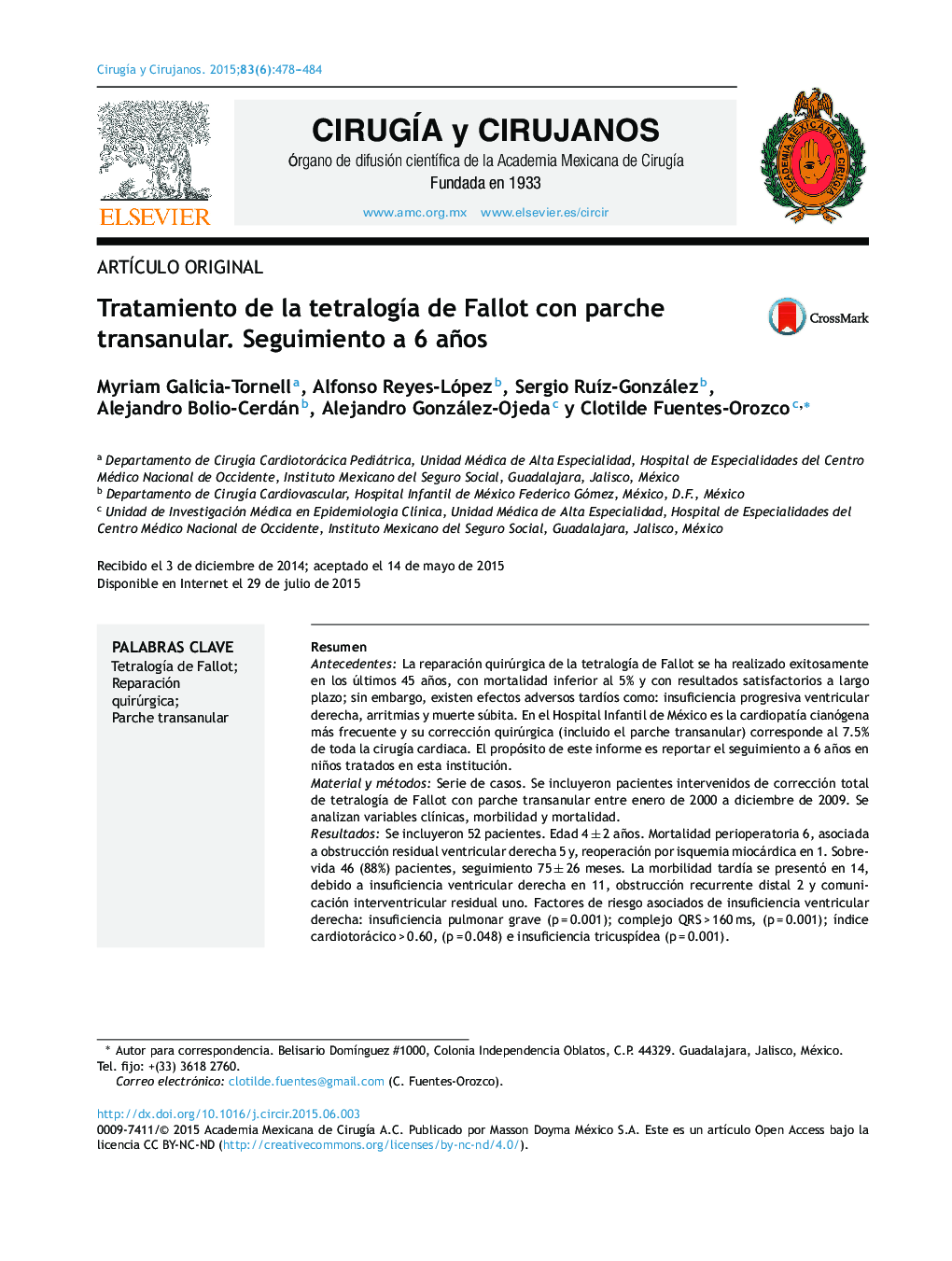| کد مقاله | کد نشریه | سال انتشار | مقاله انگلیسی | نسخه تمام متن |
|---|---|---|---|---|
| 4283277 | 1286878 | 2015 | 7 صفحه PDF | دانلود رایگان |

ResumenAntecedentesLa reparación quirúrgica de la tetralogía de Fallot se ha realizado exitosamente en los últimos 45 años, con mortalidad inferior al 5% y con resultados satisfactorios a largo plazo; sin embargo, existen efectos adversos tardíos como: insuficiencia progresiva ventricular derecha, arritmias y muerte súbita. En el Hospital Infantil de México es la cardiopatía cianógena más frecuente y su corrección quirúrgica (incluido el parche transanular) corresponde al 7.5% de toda la cirugía cardiaca. El propósito de este informe es reportar el seguimiento a 6 años en niños tratados en esta institución.Material y métodosSerie de casos. Se incluyeron pacientes intervenidos de corrección total de tetralogía de Fallot con parche transanular entre enero de 2000 a diciembre de 2009. Se analizan variables clínicas, morbilidad y mortalidad.ResultadosSe incluyeron 52 pacientes. Edad 4 ± 2 años. Mortalidad perioperatoria 6, asociada a obstrucción residual ventricular derecha 5 y, reoperación por isquemia miocárdica en 1. Sobrevida 46 (88%) pacientes, seguimiento 75 ± 26 meses. La morbilidad tardía se presentó en 14, debido a insuficiencia ventricular derecha en 11, obstrucción recurrente distal 2 y comunicación interventricular residual uno. Factores de riesgo asociados de insuficiencia ventricular derecha: insuficiencia pulmonar grave (p = 0.001); complejo QRS > 160 ms, (p = 0.001); índice cardiotorácico > 0.60, (p = 0.048) e insuficiencia tricuspídea (p = 0.001).ConclusionesEncontramos una sobrevida razonable a largo plazo y calidad de vida excelente, posterior a la corrección total de tetralogía de Fallot; sin embargo, la insuficiencia progresiva ventricular derecha obliga a un continuo seguimiento para elegir el momento óptimo de reemplazo valvular pulmonar.
BackgroundPrimary repair of Fallot tetralogy has been performed successfully for the last 45 years. It has low surgical mortality (< 5%), with excellent long-term results. However, there are delayed adverse effects: progressive right ventricular dilation and dysfunction, arrhythmia, and sudden death. In our centre, Fallot tetralogy is the most common form of cyanotic congenital heart disease (including transannular patch) and accounts for 7.5% of all cardiovascular surgical procedures. The mid-term follow-up results are reported.Material and methodsCase series. The study included patients who had complete repair of Fallot tetralogy with transannular patch from January 2000 to December 2009. An analysis was performed on the clinical variables, morbidity and mortality.ResultsThere were 52 patients in the study, with mean age 4 ± 2 years. Perioperative mortality in 6 patients, with 5 associated with residual right ventricular obstruction and, 1 associated with further surgery. The survival rate was 88% (46) patients, with a follow-up 75 ± 26 months. Late morbidity occurred in 14, due to right ventricular dysfunction in 11, recurrent distal obstruction in 2, and residual ventricular septal defect in 1. Associated risk factors were severe pulmonary insufficiency (p = 0.001); QRS > 160 ms, p = 0.001); cardiothoracic > 0.60 index, (p = 0.048), and tricuspid regurgitation (p = 0.001).ConclusionsThere was reasonable long-term survival and excellent quality of life after total correction of Fallot tetralogy; however, progressive right ventricular dysfunction requires continuous monitoring, as well as the choice of optimal timing of pulmonary valve replacement.
Journal: Cirugía y Cirujanos - Volume 83, Issue 6, November–December 2015, Pages 478–484